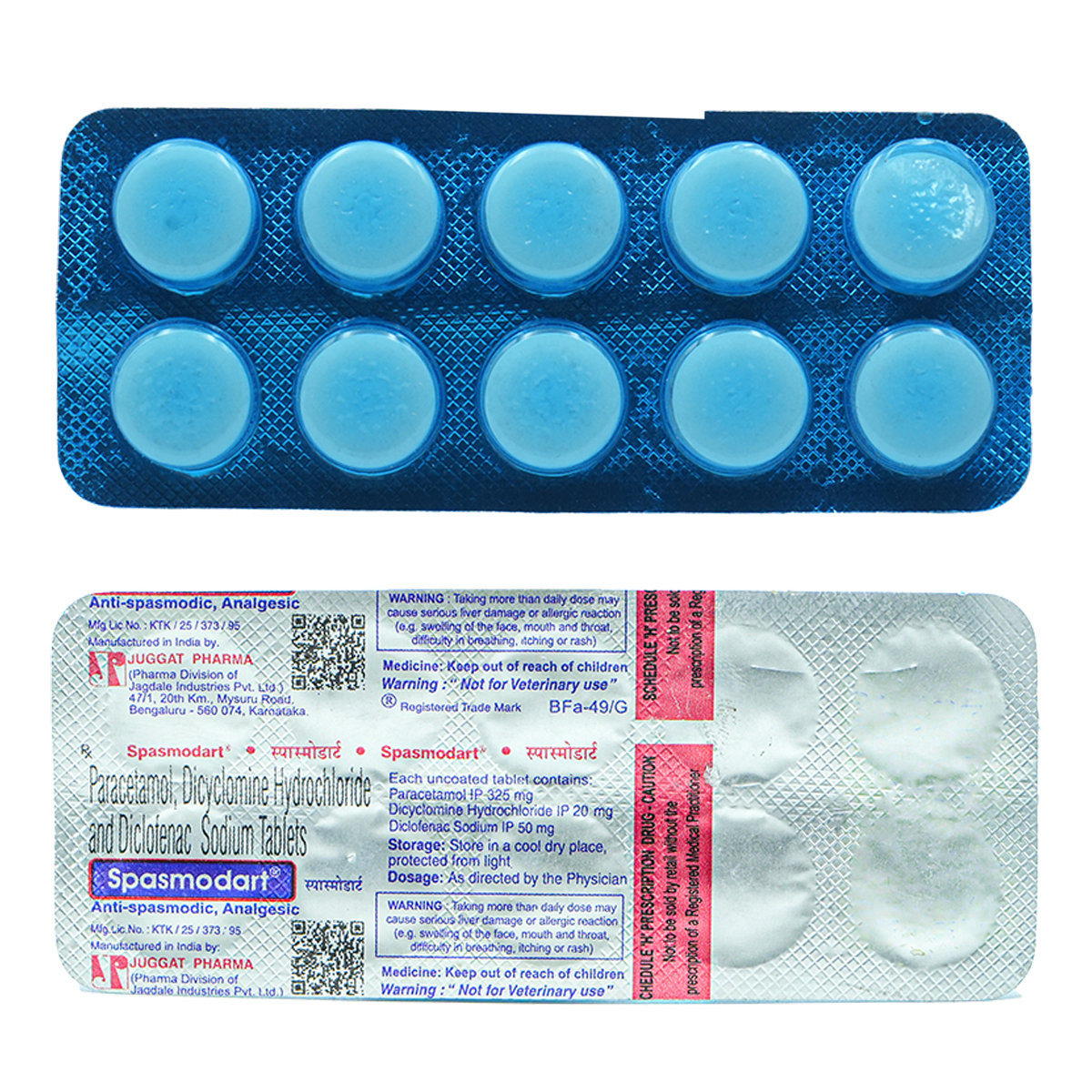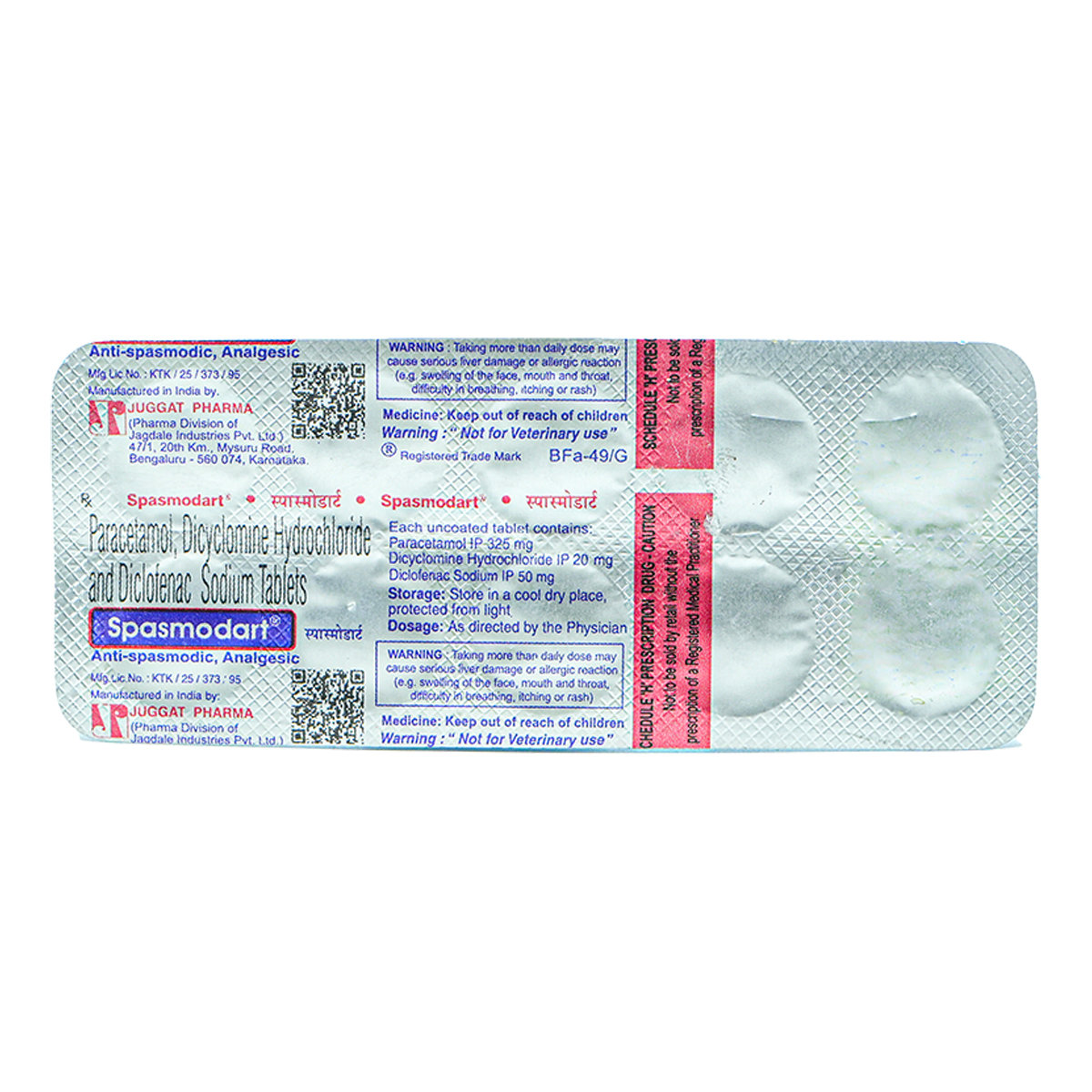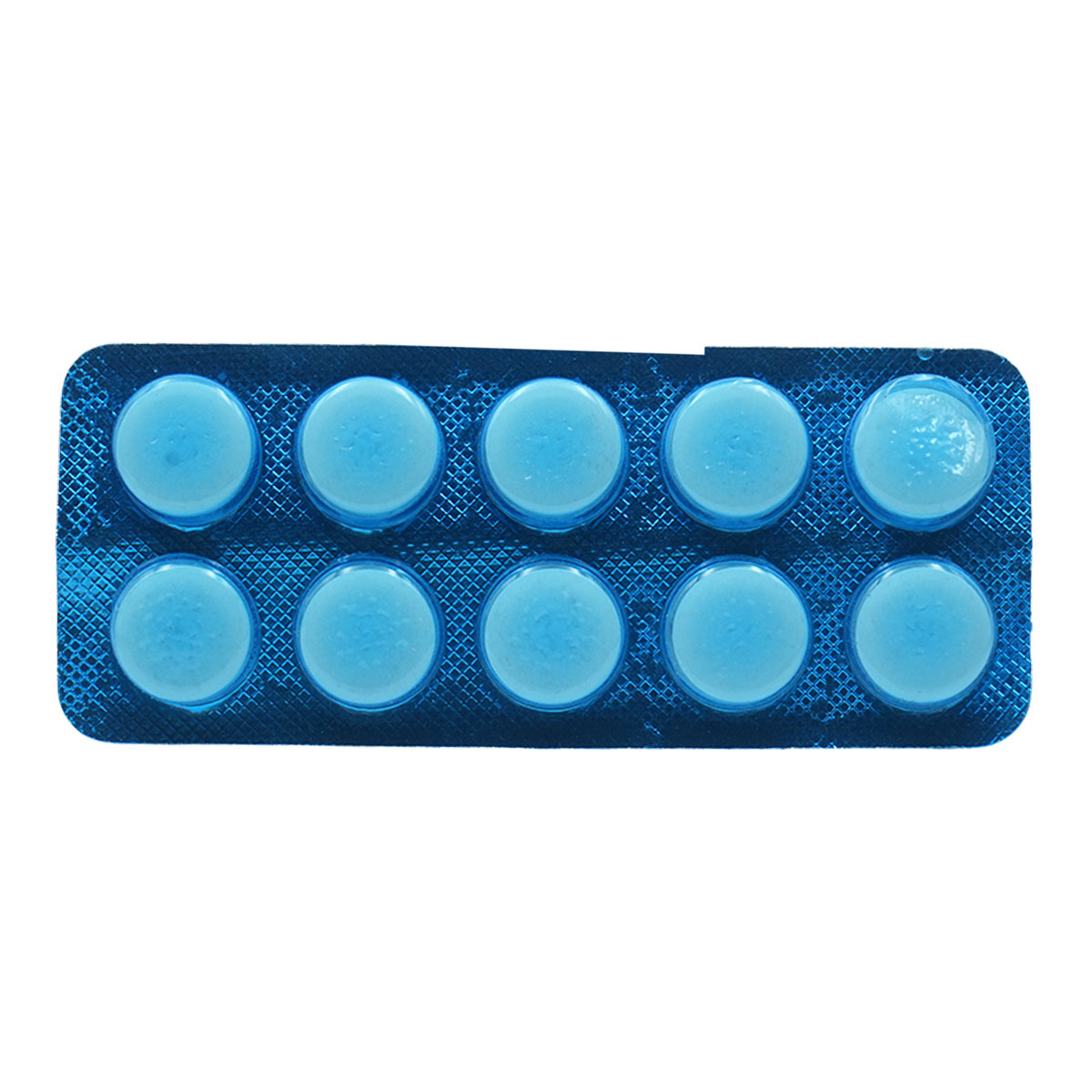Spasmodart Tablet 10's






MRP ₹62.5
(Inclusive of all Taxes)
₹9.4 Cashback (15%)
Selected Pack Size:10
10 ₹56.25
(₹5.63 per unit)
In Stock
15 ₹88.2
(₹5.88 per unit)
In Stock
Provide Delivery Location
Online payment accepted
 Prescription drug
Prescription drugWhats That
Composition :
Manufacturer/Marketer :
Consume Type :
Expires on or after :
Return Policy :
About Spasmodart Tablet
Spasmodart Tablet is a combination medicine used to relieve pain and discomfort associated with intestinal colic, biliary colic, renal colic and spasmodic dysmenorrhoea (menstrual cramps). Additionally, Spasmodart Tablet is also used to reduce pain and inflammation associated with osteoarthritis, rheumatoid arthritis, ankylosing spondylitis, backache, strain, and sprain.
Spasmodart Tablet is a combination of three drugs, namely: Diclofenac, Paracetamol and Dicyclomine. Diclofenac and Paracetamol work by blocking the effect of chemical messengers that cause pain and inflammation at the injured or damaged site. Dicyclomine works by relieving contractions associated with the smooth muscles of the abdomen. Together, Spasmodart Tablet helps in providing relief from pain.
You are advised to take Spasmodart Tablet for as long as your doctor has prescribed it for you, depending on your medical condition. In some cases, Spasmodart Tablet may cause common side-effects such as nausea, vomiting, heartburn, dizziness, and diarrhoea. Most of these side-effects do not require medical attention and will resolve gradually over time. However, you are advised to talk to your doctor if you experience these side-effects persistently.
Consult your doctor if you are pregnant or breastfeeding. Spasmodart Tablet may cause dizziness, so drive with caution. Spasmodart Tablet should not be given to children as safety and efficacy have not been established. Avoid consuming alcohol with Spasmodart Tablet as it could lead to increased dizziness; it might also increase the risk of stomach bleeding. Keep your doctor informed about your health condition and medicines to rule out any side-effects.
Uses of Spasmodart Tablet
Directions for Use
Key Benefits
Spasmodart Tablet is a combination of three drugs, namely: Diclofenac (NSAID), Paracetamol (Analgesic) and Dicyclomine (Anti-cholinergic). Spasmodart Tablet is used to relieve pain and discomfort associated with intestinal colic, biliary colic, renal colic and spasmodic dysmenorrhoea (menstrual cramps). Additionally, Spasmodart Tablet is also used to reduce pain and inflammation associated with osteoarthritis, rheumatoid arthritis, ankylosing spondylitis, backache, strain, and sprain. Diclofenac and Paracetamol work by blocking the effect of chemical messengers known as cyclo-oxygenase (COX) enzymes that make other chemical prostaglandins which are produced at injury sites and cause pain and swelling. By blocking the effect of COX enzymes, lesser prostaglandins are produced, which reduces mild to moderate pain and inflammation at the injured or damaged site. Dicyclomine works by relieving contractions associated with the smooth muscles of the abdomen. Together, Spasmodart Tablet helps in providing relief from abdominal spasms.
Storage
- Inform your doctor about the nausea and discuss possible alternatives to the medication or adjustments to the dosage.
- Divide your daily food intake into smaller, more frequent meals to reduce nausea.
- Opt for bland, easily digestible foods like crackers, toast, plain rice, bananas, and applesauce.
- Avoid certain foods that can trigger nausea, such as fatty, greasy, spicy, and smelly foods.
- Drink plenty of fluids, such as water, clear broth, or electrolyte-rich beverages like coconut water or sports drinks.
- Use ginger (tea, ale, or candies) to help relieve nausea.
- Get adequate rest and also avoid strenuous activities that can worsen nausea.
- Talk to your doctor about taking anti-nausea medication if your nausea is severe.
- Record when your nausea occurs, what triggers it, and what provides relief to help you identify patterns and manage your symptoms more effectively.
- Consume more fruits, vegetables, and cruciferous foods like cabbage, kale, and broccoli.
- Reduced alcohol intake can enhance liver enzyme function.
- Oxidative stress can be managed by eating foods rich in antioxidants, such as vitamins C and E.
- Liver function tests regularly can help manage increased levels of AST.
- Tell your doctor immediately if you experience shortness of breath after taking medication.
- Your doctor may adjust the medication regimen or dosage or give alternative medical procedures to minimize the symptoms of shortness of breath.
- Monitor your oxygen levels and breathing rate regularly to track changes and potential side effects.
- For controlling stress and anxiety, try relaxation techniques like deep breathing exercises, meditation, or yoga.
- Make lifestyle changes, such as quitting smoking, exercising regularly, and maintaining a healthy weight.
- Seek emergency medical attention if you experience severe shortness of breath, chest pain, or difficulty speaking.
- Follow up regularly with your doctor to monitor progress, adjust treatment plans, and address any concerns or questions.
- Talk to your doctor about oral potassium supplements.
- Eat potassium rich foods such as bananas, avocados, oranges, dark leafy greens, beans and peas, fish, spinach, milk and tomatoes.
- Gently massage the affected area using your hands or a massager.
- Light exercises such as walking or climbing stairs may help the muscles return to normal.
- Apply heat/ice to the affected area.
- Drink electrolyte-rich fluids.
- Rest well; get enough sleep.
- Eat a balanced diet and drink enough water.
- Manage stress with yoga and meditation.
- Limit alcohol and caffeine.
- Physical activities like walking or jogging might help boost energy and make you feel less tired.
Drug Warnings
Do not take Spasmodart Tablet if you are allergic to any of its contents; if you have/had severe heart problems, stomach ulcer or perforation, and bleeding problems such as bleeding from the stomach. Inform your doctor if you have/had high blood pressure, heart problems, high cholesterol, diabetes, asthma, bypass surgery, heart attack, blood circulation problems, inflammation of intestines, liver or kidney problems. Consult your doctor if you are pregnant or breastfeeding. Spasmodart Tablet may cause dizziness, so drive only if you are alert. Spasmodart Tablet is not recommended for children as safety and effectiveness have not been established. Avoid consuming alcohol along with Spasmodart Tablet as it could lead to increased dizziness and can increase the risk of stomach bleeding. Stop taking Spasmodart Tablet and consult your doctor immediately if you have stomach pain or any signs of bleeding in the intestine or stomach, such as blood in stools. Do not take any other NSAIDs for pain relief along with Spasmodart Tablet unless prescribed.
Drug-Drug Interactions
Drug-Drug Interactions
Login/Sign Up
Co-administration of Spasmodart Tablet with Meloxicam can increase the risk or severity of gastrointestinal side effects.
How to manage the interaction:
Taking Meloxicam with Spasmodart Tablet is not recommended as it can possibly result in an interaction, it can be taken if your doctor has advised it. However, consult your doctor immediately if you experience symptoms such as dizziness, lightheadedness, red or black, tarry stools, coughing up or vomiting fresh or dried blood that looks like coffee grounds, severe headache, and weakness. Do not stop any medication without doctor's advise.
Taking Spasmodart Tablet and Potassium citrate together can increase the risk of stomach ulcers, bleeding, and gastrointestinal injury.
How to manage the interaction:
Taking Spasmodart Tablet with Potassium citrate is not recommended, as it may lead to an interaction, it can be taken if prescribed by the doctor. However, if you experience severe stomach pain, bloating, sudden lightheadedness or dizziness, nausea, vomiting (especially with blood), decreased hunger, or dark, tarry stools, consult the doctor immediately. Do not discontinue any medications without a doctor's advice.
Co-administration of Pramlintide with Spasmodart Tablet can increase the risk of reduced gastrointestinal movement.
How to manage the interaction:
Taking Spasmodart Tablet with Pramlintide is not recommended, please consult your doctor before taking it. Do not discontinue the medication without consulting a doctor.
Co-administration of Spasmodart Tablet with Potassium chloride can increase the risk of stomach ulcers.
How to manage the interaction:
Taking Spasmodart Tablet with Potassium chloride is not recommended, as it can lead to an interaction, it can be taken if a doctor has prescribed it. However, if you experience severe stomach pain, bloating, sudden lightheadedness or dizziness, nausea, vomiting (especially with blood), decreased hunger, dark, tarry stools, consult the doctor immediately. Do not discontinue the medication without consulting a doctor.
Taking Spasmodart Tablet with Enoxaparin can increase the risk of bleeding complications.
How to manage the interaction:
There may be a possible interaction between Spasmodart Tablet and Enoxaparin, but they can be taken together if your doctor has prescribed them. However, consult your doctor immediately if you experience any unusual bleeding or bruising, swelling, vomiting, blood in your urine or stools, headache, dizziness, or weakness. Do not discontinue any medications without consulting a doctor.
Coadministration of Spasmodart Tablet with Ketoconazole may increase the risk of liver problems.
How to manage the interaction:
There may be a possible interaction between Spasmodart Tablet and Ketoconazole, but they can be taken together if a doctor has prescribed them. However, consult a doctor immediately if you have fever, chills, joint pain or swelling, unusual bleeding or bruising, skin rash, itching, loss of appetite, fatigue, nausea, vomiting, abdominal pain, dark colored urine, light colored stools, and/or yellowing of the skin or eyes. Do not discontinue any medications without consulting a doctor.
Taking Spasmodart Tablet with human immunoglobulin may increase the risk of kidney problems.
How to manage the interaction:
Although there is an interaction between Human immunoglobulin and Spasmodart Tablet, you can take these medicines together if prescribed by a doctor. However, consult the doctor immediately if you experience symptoms such as nausea, vomiting, loss of appetite, increased or decreased urination, sudden weight gain or weight loss, fluid retention, swelling, shortness of breath, muscle cramps, tiredness, weakness, dizziness, confusion, and irregular heart rhythm. Do not discontinue any medications without consulting a doctor.
Taking Spasmodart Tablet with Ibrutinib can increase the risk of bleeding tendencies.
How to manage the interaction:
There may be a possible interaction between Spasmodart Tablet and Ibrutinib, but they can be taken together if a doctor has prescribed them. However, consult a doctor immediately if you experience any unusual bleeding, dizziness, lightheadedness, red or black, tarry stools, coughing up or vomiting fresh or dried blood that looks like coffee grounds, or severe headaches. Do not discontinue any medications without consulting a doctor.
Co-administration of Spasmodart Tablet with Celecoxib may increase the risk of stomach bleeding and ulcers.
How to manage the interaction:
Although there is a interaction between Spasmodart Tablet and Celecoxib, but it can be taken if your doctor has advised it. Consult a doctor if you experience symptoms like blood in your urine or stool (or a black stool), severe bruising, prolonged nosebleeds, feeling dizzy or lightheaded, weakness or severe headache, vomiting blood or coughing up blood, heavy menstrual bleeding (in women), difficulty breathing, or chest pain. Do not discontinue any medication without consulting a doctor.
Co administration of Spasmodart Tablet with Leflunomide may result in liver problems.
How to manage the interaction:
Co-administration of Spasmodart Tablet and Leflunomide can lead to an interaction; it can be taken if advised by your doctor. However, if you have a fever, chills, joint pain or swelling, unusual bleeding or bruising, skin rash, itching, loss of appetite, fatigue, nausea, vomiting, abdominal pain, dark-colored urine, light-colored stools, or yellowing of the skin or eyes. Do not stop using any medication without consulting your doctor.
Drug-Food Interactions
Drug-Food Interactions
Login/Sign Up
Diet & Lifestyle Advise
- Exercising regularly helps in muscle stretching so that they are less likely to spasm, tear and sprain. Mild exercises such as jogging and walking are helpful for muscle stretching.
- Massages can also be helpful.
- Avoid freezing and hot temperatures.
- Avoid wearing tight-fitting clothes; instead, wear loose garments.
- Rest well, and get plenty of sleep.
- To avoid developing pressure sores, change your position every two hours.
- Hot or cold therapy can help treat muscle spasms. Apply an ice-pack or hot-pack on the muscle for 15-20minutes.
- Stay hydrated, drink plenty of water.
Side Effects of Spasmodart Tablet
- Nausea
- Vomiting
- Diarrhoea
- Heartburn
- Dizziness
Habit Forming
Therapeutic Class
All Substitutes & Brand Comparisons
RX
Out of StockSpasmo Diflam Tablet
₹19.7
(₹1.77 per unit)
68% CHEAPERRX
Out of StockDispasm D Tablet
Acron Pharmaceuticals
₹20
(₹1.8 per unit)
68% CHEAPERRX
Out of StockZodol 20mg/50mg/325mg Tablet
Meridian Medicare Ltd
₹20
(₹1.8 per unit)
68% CHEAPER
Product Substitutes
Author Details
We provide you with authentic, trustworthy and relevant information
Drug-Diseases Interactions
Drug-Diseases Interactions
Login/Sign Up
FAQs
Spasmodart Tablet contains Diclofenac, Paracetamol and Dicyclomine. Diclofenac and Paracetamol work by blocking the effect of chemical messengers that cause inflammation at the injured or damaged site. Dicyclomine works by relieving contractions associated with the smooth muscles of the abdomen. Together, Spasmodart Tablet helps in providing relief from pain.
Diarrhoea might be a side-effect of Spasmodart Tablet . Drink enough fluids and eat non-spicy food if you experience diarrhoea. Consult your doctor if you experience severe diarrhoea or if you find blood in stools.
Do not take any other pain killer medicines along with Spasmodart Tablet unless prescribed as it might lead to unpleasant side-effects and can increase the risk of stomach bleeding associated with NSAIDs.
Dry mouth could be a side-effect of Spasmodart Tablet . Limiting caffeine intake, avoiding smoking and mouthwashes containing alcohol, drinking water regularly and chewing sugar-free gum/candy might help in stimulating saliva and thereby prevents drying of the mouth.
Spasmodart Tablet should be taken for longer durations only if prescribed by the doctor. Avoid taking Spasmodart Tablet for longer durations as it might increase the risk of heart problems and stomach bleeding.
Spasmodart Tablet may be used to treat dysmenorrhea (period pain), pain due to heavy bleeding during periods and menstrual cramps. Take Spasmodart Tablet only as prescribed, and do not overdose.
Drug-Drug Interactions Checker List
- DIPHENHYDRAMINE
- METOPROLOL
- ASPIRIN
- HYDROCODONE
- DULOXETINE
Disease/Condition Glossary
Abdominal pain and cramps: Abdominal pain occurs between the chest and pelvic region, generally known as stomach or tummy pain. Pain is a symptom triggered by the nervous system, causing uncomfortable sensations in the body. Muscle spasm is the sudden involuntary contractions of the muscle, which can be painful and uncomfortable. When the nerve impulses that control the muscle movements are damaged or interrupted, it could lead to muscle spasms. The common causes of abdominal pain include inflammation, infections, intestinal disorders and obstruction/blockage. Abdominal pain could be generalised, localised, cramps or colicky pain.
Musculoskeletal pain: Musculoskeletal pain affects the bones, muscles, ligaments, tendons, and nerves. It could occur due to arthritis, osteoporosis, fractures, dislocations, problems with the bone structure or injury to the bones, joints, tendons, muscles and ligaments. Symptoms of musculoskeletal pain include stiffness, swelling, redness, weakness, muscle spasms or twitching, trouble moving the affected area, and soreness.

Have a query?
Buy best Gastro Enterology products by
Abbott India Ltd
Sun Pharmaceutical Industries Ltd
Alkem Laboratories Ltd
Cipla Ltd
Torrent Pharmaceuticals Ltd
Intas Pharmaceuticals Ltd
Mankind Pharma Pvt Ltd
Lupin Ltd
Dr Reddy's Laboratories Ltd
Aristo Pharmaceuticals Pvt Ltd
Alembic Pharmaceuticals Ltd
Wallace Pharmaceuticals Pvt Ltd
La Renon Healthcare Pvt Ltd
Leeford Healthcare Ltd
Macleods Pharmaceuticals Ltd
J B Chemicals & Pharmaceuticals Ltd
Zydus Healthcare Ltd
Micro Labs Ltd
Zydus Cadila
Fourrts India Laboratories Pvt Ltd
Morepen Laboratories Ltd
Zuventus Healthcare Ltd
FDC Ltd
Eris Life Sciences Ltd
Cadila Pharmaceuticals Ltd
Medishri Healthcare Pvt Ltd
Alniche Life Sciences Pvt Ltd
Medley Pharmaceuticals Ltd
Tas Med India Pvt Ltd
Signova Pharma
Tablets India Ltd
Elder Pharmaceuticals Ltd
Wockhardt Ltd
Emcure Pharmaceuticals Ltd
Sanatra Healthcare Ltd
Glenmark Pharmaceuticals Ltd
Blue Cross Laboratories Pvt Ltd
East West Pharma India Pvt Ltd
Hetero Drugs Ltd
Indoco Remedies Ltd
Vasu Organics Pvt Ltd
Biological E Ltd
Primus Remedies Pvt Ltd
Akumentis Healthcare Ltd
Corona Remedies Pvt Ltd
Pfizer Ltd
Albert David Ltd
DR Johns Lab Pharma Pvt Ltd
Ajanta Pharma Ltd
Cadila Healthcare Ltd
Ipca Laboratories Ltd
Ordain Health Care Global Pvt Ltd
Systopic Laboratories Pvt Ltd
Ozone Pharmaceuticals Ltd
Foregen Healthcare Ltd
Medgen Drugs And Laboratories Pvt Ltd
Panacea Biotec Ltd
Samarth Life Sciences Pvt Ltd
Shine Pharmaceuticals Ltd
Adonis Laboratories Pvt Ltd
Dey's Medical Stores (Mfg) Ltd
Eskag Pharma Pvt Ltd
Hetero Healthcare Pvt Ltd
Indchemie Health Specialities Pvt Ltd
Meyer Organics Pvt Ltd
RPG Life Sciences Ltd
Troikaa Pharmaceuticals Ltd
Biochem Pharmaceutical Industries Ltd
Shreya Life Sciences Pvt Ltd
Sinsan Pharmaceuticals Pvt Ltd
3M India Ltd
Chemo Healthcare Pvt Ltd
Levin Life Sciences Pvt Ltd
Meridian Enterprises Pvt Ltd
Overseas Health Care Pvt Ltd
Saf Fermion Ltd
Sanzyme Pvt Ltd
Steris Healthcare
USV Pvt Ltd
Seagull Pharmaceutical Pvt Ltd
Votary Laboratories (India) Ltd
Win Medicare Ltd
Yuventis Pharmaceuticals
Aar Ess Remedies Pvt Ltd
Caplet India Pvt Ltd
Piramal Enterprises Ltd
Sanofi India Ltd
Cnx Health Care Pvt Ltd
Galpha Laboratories Ltd
Intra Labs India Pvt Ltd
Kinesis Pharmaceuticals Pvt Ltd
Msn Laboratories Pvt Ltd
Olcare Laboratories Pvt Ltd
Rapross Pharmaceuticals Pvt Ltd
Ronyd Healthcare Pvt Ltd
Saffron Therapeutics Pvt Ltd
Solariz Healthcare Pvt Ltd
Syndicate Life Sciences Pvt Ltd
Aurz Pharmaceutical Pvt Ltd
Biophar Lifesciences Pvt Ltd
Alcohol
Safe if prescribed
Avoid consumption of alcohol while taking Spasmodart Tablet as it may increase dizziness. It can also increase the risk of stomach bleeding.
Pregnancy
Consult your doctor
Please consult your doctor if you are pregnant; your doctor will prescribe only if the benefits outweigh the risks.
Breast Feeding
Consult your doctor
Consult your doctor before taking Spasmodart Tablet ; your doctor will decide whether Spasmodart Tablet can be taken by breastfeeding mothers or not.
Driving
Safe if prescribed
Spasmodart Tablet may cause dizziness. Do not drive or operate machinery unless you are alert.
Liver
Consult your doctor
Dose adjustment may be needed in patients with liver impairment. Please consult your doctor if you have a liver impairment or any concerns regarding this.
Kidney
Consult your doctor
Dose adjustment may be needed in patients with kidney impairment. Please consult your doctor if you have kidney impairment or any concerns regarding this.
Children
Safe if prescribed
Spasmodart Tablet should not be given to children as the safety and effectiveness were not established.





_0.jpg?tr=q-85)

